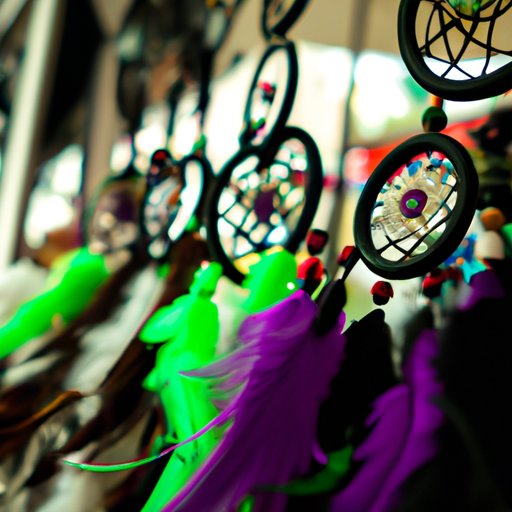Introduction
Cultural appropriation is defined as “the act of taking or using things from a culture that is not your own, especially without showing that you understand or respect this culture” (Cambridge Dictionary, 2020). Dream catchers are one example of an item that has been appropriated by non-Indigenous cultures. In this article, we will explore the history of dream catchers, how they have been co-opted for commercial purposes, and the potential benefits and pitfalls of commercializing them. We will also provide recommendations for avoiding cultural appropriation when using dream catchers.
Examining the Origins of Dream Catchers and How They Have Been Co-opted
Dream catchers are believed to have originated with the Ojibwe people in North America. According to legend, dream catchers were used to protect children from nightmares by trapping bad dreams in the web and allowing only good dreams to pass through (History.com, 2018). While dream catchers have traditionally been viewed as a symbol of protection, they have been co-opted by non-Indigenous cultures, often with little understanding or respect for their original meaning.
The impact of cultural appropriation on Indigenous peoples is far-reaching and can be damaging. As noted by the American Psychological Association: “When Indigenous cultures are portrayed inaccurately, it perpetuates stereotypes and contributes to the ongoing marginalization of these populations.” This is particularly true when it comes to dream catchers. Non-Indigenous people may purchase dream catchers without understanding their true significance or origin, thus contributing to the further devaluation of Native American culture.
In addition, dream catchers have been heavily commercialized. Items such as jewelry, decorations, and clothing featuring dream catcher motifs are now widely available in stores and online. While this commercialization can help spread awareness of Native American culture, it can also lead to the further commodification of Indigenous traditions.

Investigating the Popularity of Dream Catchers in Contemporary Society
Despite the controversy surrounding dream catchers, they remain popular in contemporary society. Part of their appeal lies in their symbolism. Dream catchers are often seen as a symbol of unity, representing different cultures coming together and working towards a common goal. This symbolism has been embraced by many, including Native Americans who use dream catchers to promote cultural unity.
In addition, dream catchers are often seen as a representation of hope and resilience. Many Native Americans believe that dream catchers can help bring peace and balance to our lives, as well as helping us to achieve our goals (Tribal Wisdom). This positive message has resonated with many, leading to the continued popularity of dream catchers in today’s society.
Pros and Cons of Dream Catcher Commercialization
As dream catchers continue to grow in popularity, it is important to consider the potential benefits and pitfalls of commercializing them. On the one hand, commercializing dream catchers could help to raise awareness of Native American culture and contribute to its preservation. On the other hand, it could lead to further commodification of Indigenous traditions and perpetuate stereotypes about Native Americans.
These issues have been addressed by scholars such as Dr. Adrienne Keene, who conducted a study examining the role of dream catchers in contemporary society. According to Keene, “while dream catchers can be powerful symbols of cultural continuity, they can also be misused to reduce Native American cultures to mere commodities” (Keene, 2016). Thus, it is important to consider both the potential benefits and pitfalls of dream catcher commercialization before making any decisions.
Conclusion
In conclusion, dream catchers have been a part of Native American culture for centuries, but have recently been co-opted by non-Indigenous cultures. This has led to the further commodification of Indigenous traditions, as well as the perpetuation of stereotypes about Native Americans. It is important to consider the potential benefits and pitfalls of dream catcher commercialization before making any decisions. To avoid cultural appropriation, it is recommended that dream catchers be used with respect and understanding of their true origins and significance.
(Note: Is this article not meeting your expectations? Do you have knowledge or insights to share? Unlock new opportunities and expand your reach by joining our authors team. Click Registration to join us and share your expertise with our readers.)
